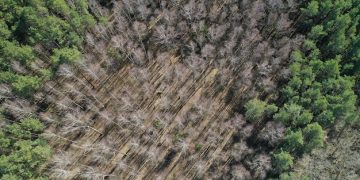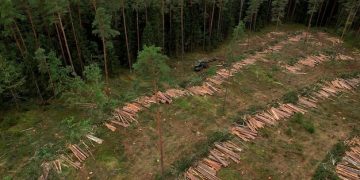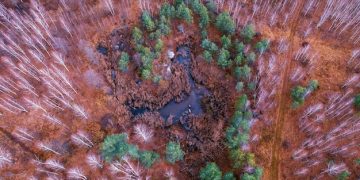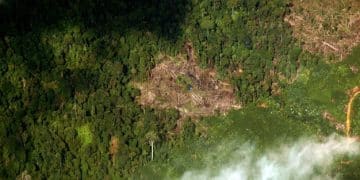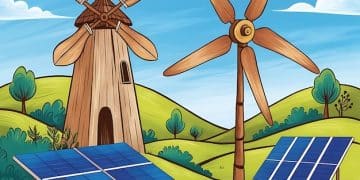Deforestation & Landslides: Are US Mountain Towns Ready?
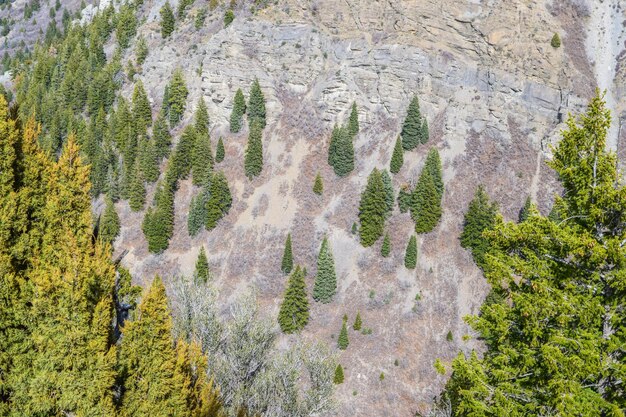
Deforestation significantly increases the risk of landslides in US mountain communities by removing vital tree cover that stabilizes soil, raising concerns about preparedness and safety measures.
Are US mountain communities prepared for the increasing threat of landslides due to deforestation? The connection between deforestation and the increase in landslides: Are US mountain communities prepared? is becoming increasingly clear, demanding urgent attention and proactive strategies.
Understanding the Deforestation-Landslide Link in US Mountains
The relationship between deforestation and landslides is a critical issue, especially in mountainous regions of the United States. Forests play a crucial role in maintaining soil stability. When trees are removed, the risk of landslides increases significantly.
Understanding this link is essential for developing effective strategies to protect vulnerable communities. Here’s why deforestation leads to more landslides:
Root Systems and Soil Stability
Tree roots act as natural anchors, binding soil particles together and preventing erosion. When forests are cleared, these root systems decay, weakening the soil structure.
Water Absorption and Runoff
Forests also absorb rainwater, reducing surface runoff and preventing soil saturation. Deforestation disrupts this natural process, leading to increased runoff and a higher risk of landslides.

Consider these key factors:
- Loss of Interception: Trees intercept rainfall, reducing the amount of water that reaches the ground.
- Reduced Evapotranspiration: Forests help remove water from the soil through transpiration. Deforestation decreases this process, increasing soil moisture.
- Increased Soil Erosion: Without tree cover, soil is more exposed to wind and water erosion, further destabilizing the land.
Ultimately, understanding the direct relationship can lead to more informed land management and disaster preparedness policies. Protecting our forests is not just an environmental issue; it’s a matter of community safety and resilience.
The Impact of Deforestation on US Mountain Regions
Deforestation impacts US mountain regions in multiple ways, including increased landslide frequency and severity. Specific regions are particularly vulnerable due to their topography, climate, and land use practices.
Let’s examine some of the key effects of deforestation on these communities:
Examples of Vulnerable Regions
Regions like the Appalachian Mountains, the Rocky Mountains, and the Pacific Northwest face significant landslide risks due to deforestation. These areas often experience heavy rainfall and have steep slopes, making them susceptible to soil erosion.
Consequences for Local Communities
Landslides can destroy homes, roads, and infrastructure, isolating communities and disrupting essential services. The economic costs associated with landslide damage can be substantial, affecting property values and local businesses.
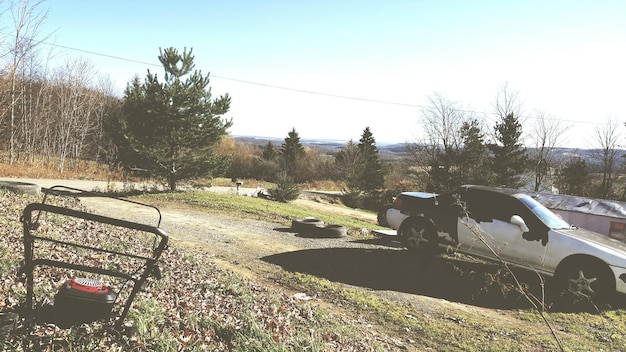
Here’s a breakdown of the consequences for local communities:
- Infrastructure Damage: Roads, bridges, and utilities can be severely damaged or destroyed by landslides.
- Economic Losses: Property values plummet, and businesses suffer as a result of landslide damage.
- Displacement: Families may be forced to evacuate their homes, leading to long-term displacement and social disruption.
Addressing these impacts requires a comprehensive approach that combines reforestation efforts with improved land use planning and disaster preparedness measures. Protecting mountain communities from the devastating effects of landslides is a shared responsibility that demands proactive action.
Current Landslide Preparedness in US Mountain Communities
Many US mountain communities face significant challenges in preparing for landslides. Limited resources, inadequate infrastructure, and a lack of awareness can hinder effective preparedness efforts. The existing resources can be strengthened through better planning and allocation.
Effective preparedness involves several key components:
Early Warning Systems
Early warning systems can provide timely alerts to residents, allowing them to evacuate before a landslide occurs. However, many mountain communities lack access to such systems or have systems that are not adequately maintained.
Emergency Response Plans
Emergency response plans outline the steps that local authorities and residents should take in the event of a landslide. These plans must be regularly updated and communicated effectively to the community.
Consider these crucial preparedness measures:
- Community Education: Raising awareness about landslide risks and preparedness measures is essential.
- Infrastructure Improvements: Investing in infrastructure that can withstand landslides, such as retaining walls and drainage systems, is vital.
- Land Use Planning: Implementing land use policies that restrict development in high-risk areas can reduce vulnerability.
By investing in these areas, US mountain communities can enhance their resilience to landslides. Preparedness is not just about reacting to disasters; it’s about proactively reducing risks and protecting lives and property.
Deforestation Regulations and Their Enforcement
Deforestation regulations play a crucial role in mitigating landslide risks, but their effectiveness depends on strict enforcement. Varying regulations across different states and regions can lead to inconsistent protection levels, creating gaps in overall safety.
Let’s explore the current state of deforestation regulations and their enforcement:
Federal and State Regulations
Federal laws, such as the National Forest Management Act, provide a framework for sustainable forest management on federal lands. State regulations vary widely, with some states having stricter rules than others.
Challenges in Enforcement
Enforcement of deforestation regulations can be challenging due to limited resources, jurisdictional issues, and political pressures. Illegal logging and unauthorized land clearing continue to pose significant threats.
Here are key aspects of effective enforcement:
- Monitoring and Surveillance: Regular monitoring of forest areas is essential to detect illegal activities.
- Penalties and Fines: Strong penalties and fines can deter illegal deforestation practices.
- Collaboration and Coordination: Effective enforcement requires collaboration between federal, state, and local agencies.
Strengthening deforestation regulations and improving their enforcement is crucial for protecting US mountain communities from landslides. A consistent and robust regulatory framework can help ensure that forests are managed sustainably, reducing the risk of devastating landslides.
Reforestation Efforts and Their Long-Term Impact
Reforestation efforts are vital for restoring soil stability and reducing landslide risks in deforested areas. Planting trees can help rebuild root systems, absorb rainwater, and prevent soil erosion. Strategic reforestation can make areas more resilient over time.
Examining the benefits and challenges of reforestation is essential for effective land management:
Benefits of Reforestation
Reforestation can stabilize slopes, reduce surface runoff, and improve soil health. It also provides numerous environmental benefits, such as carbon sequestration and habitat restoration.
Challenges in Implementation
Reforestation projects can be costly and time-consuming. They require careful planning, appropriate species selection, and ongoing maintenance to ensure success.
Key strategies for successful reforestation include:
- Species Selection: Choosing native tree species that are well-suited to the local climate and soil conditions is crucial.
- Community Involvement: Engaging local communities in reforestation efforts can foster a sense of ownership and ensure long-term sustainability.
- Monitoring and Maintenance: Regular monitoring and maintenance are necessary to address issues such as pest infestations and competition from invasive species.
Investing in reforestation is a long-term strategy that can yield significant benefits for US mountain communities. By restoring deforested areas, we can enhance soil stability, reduce landslide risks, and create more resilient landscapes.
The Role of Climate Change in Exacerbating Landslide Risks
Climate change is exacerbating landslide risks in US mountain communities by altering precipitation patterns and increasing the frequency of extreme weather events. More extreme weather can overwhelm existing infrastructure and natural defenses.
Understanding the impact of climate change is critical for developing effective adaptation strategies:
Changes in Precipitation Patterns
Climate change is leading to more intense rainfall events, which can saturate soils and trigger landslides. Longer periods of drought can also weaken soil structure, making it more vulnerable to erosion.
Extreme Weather Events
Extreme weather events, such as hurricanes and severe storms, can cause widespread deforestation and landslides. These events can overwhelm existing infrastructure and emergency response capabilities.
Here are essential adaptation strategies for addressing climate change impacts:
- Improved Drainage Systems: Upgrading drainage systems can help manage increased surface runoff and prevent soil saturation.
- Early Warning Systems: Investing in advanced early warning systems can provide timely alerts to residents.
- Climate-Resilient Infrastructure: Building infrastructure that can withstand extreme weather events is crucial for protecting communities.
Adapting to climate change is essential for safeguarding US mountain communities from landslides. By implementing proactive measures, we can reduce vulnerability and build more resilient landscapes.
| Key Point | Brief Description |
|---|---|
| 🌳 Deforestation Link | Tree removal increases landslide risk by weakening soil. |
| ⚠️ Vulnerable Regions | Appalachians, Rockies, and Pacific Northwest face high risks. |
| 🛡️ Preparedness | Early warning systems and community education are crucial. |
| 🌍 Climate Change | Intense rainfall exacerbates landslide risks significantly. |
FAQ
▼
Deforestation removes tree roots that stabilize soil, leading to increased erosion and higher likelihood of landslides, especially in mountainous areas.
▼
The Appalachian Mountains, Rocky Mountains, and the Pacific Northwest face high landslide risks due to a combination of deforestation and steep terrain.
▼
Landslides can destroy homes, roads, and infrastructure, leading to significant economic losses, reduced property values, and disruption of essential services.
▼
Communities can implement early warning systems, update emergency response plans, improve drainage systems, and educate residents about landslide risks and safety measures.
▼
Climate change leads to more intense rainfall events and extreme weather, which can saturate soils and trigger more frequent and severe landslides in vulnerable areas.
Conclusion
In conclusion, addressing the relationship between deforestation and the increase in landslides: Are US mountain communities prepared? requires a multifaceted approach that combines responsible land management, stronger regulations, and community preparedness. By prioritizing forest conservation and investing in resilience measures, we can protect vulnerable communities.
